Gravel: Knowing The Different Types and Uses
Table of Contents:
When you’re tackling an outdoor project, selecting the right gravel can feel overwhelming. Isn’t it just a bunch of tiny stones?
With so many types, sizes, and colors, how do you choose the best gravel for driveways, pathways, drainage, or decorative landscaping? The good news? It’s simpler than you think.
Gravel is one of many landscaping materials that add an extra layer of depth to a landscape. With its contrast of colors, textures, and shapes, gravel can break up sightlines and create focal points to add more visual variety to your landscape, while also providing functionality and assisting with drainage.
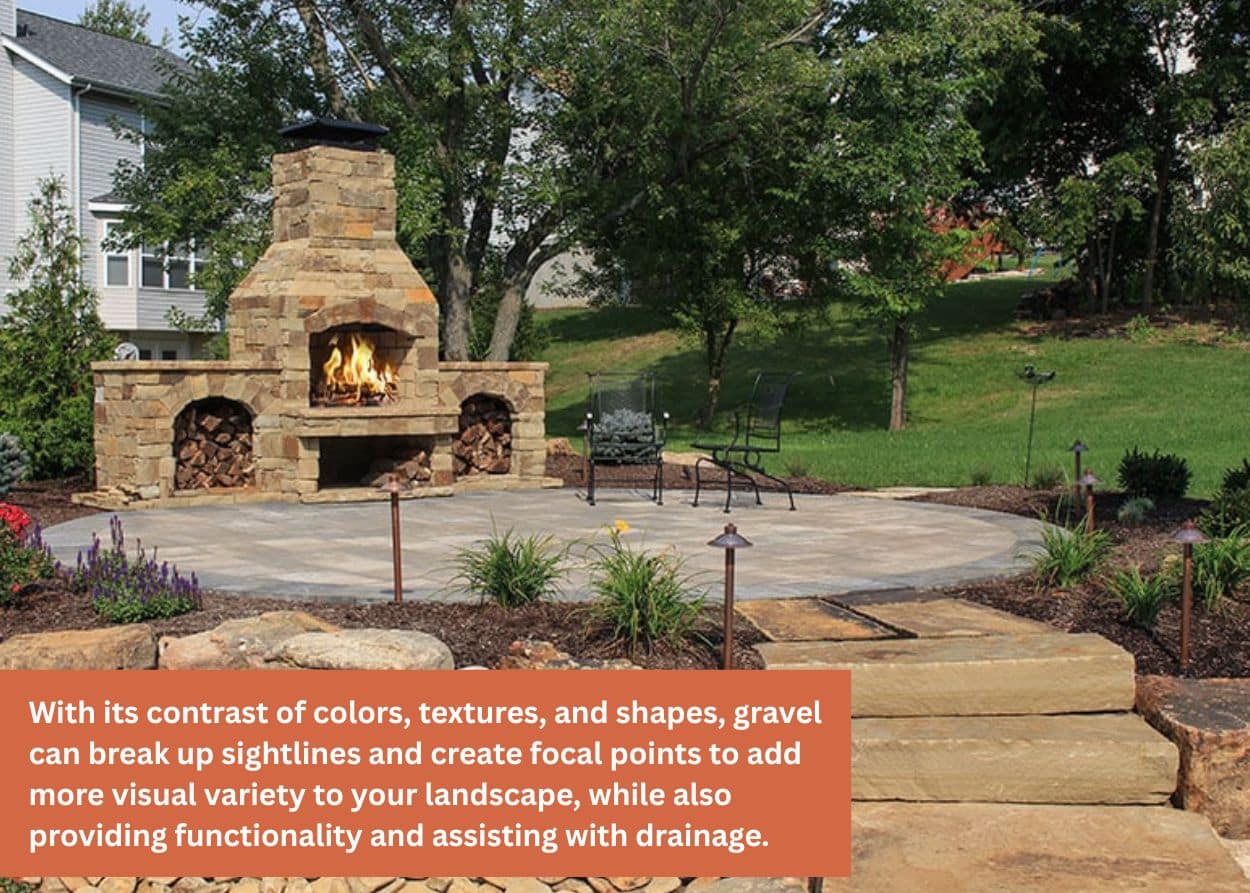
At Terrascape Supply, we’ve been in the landscaping business for over 25 years. We’ve accumulated a wealth of knowledge and experience on gravel that we’re sharing with you in this blog to help you understand the subtleties of landscaping with gravel. You could say we have a rock-solid reputation in this field!
Ready? Let’s get started!
Understanding Different Types of Gravel
Gravel has a long history in landscape design, and it’s deceivingly brilliant. Initially used for practical purposes in drainage and pathways, its use later evolved into decorative elements in various garden styles. From Japanese dry gardens to Victorian garden design, the humble gravel can tie design elements of your landscape together, while also providing crucial drainage.
To build your beautiful landscape, gravel comes in various types, each suited for specific uses. Let’s break down the most common:
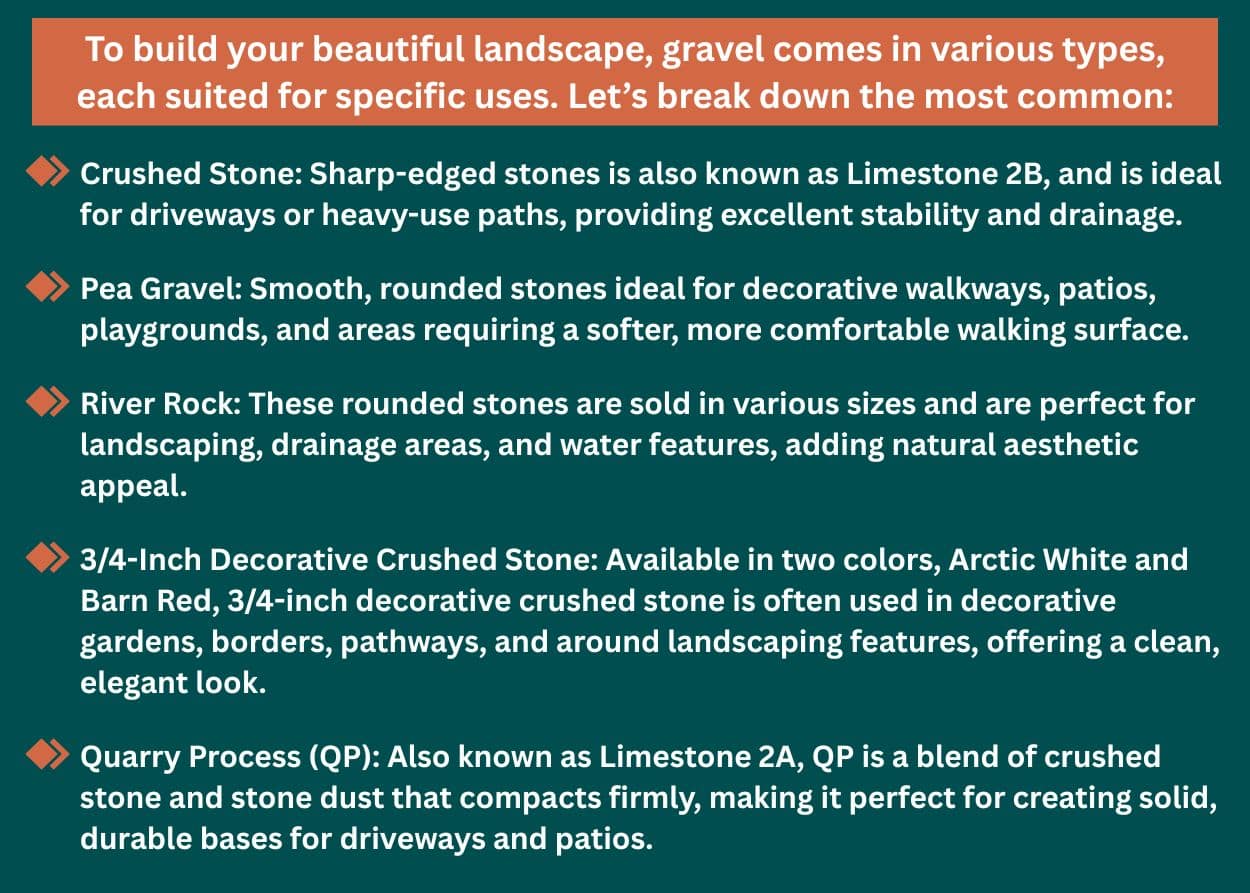
- Crushed Stone: Sharp-edged stones is also known as Limestone 2B, and is ideal for driveways or heavy-use paths, providing excellent stability and drainage.
- Pea Gravel: Smooth, rounded stones ideal for decorative walkways, patios, playgrounds, and areas requiring a softer, more comfortable walking surface.
- River Rock: These rounded stones are sold in various sizes and are perfect for landscaping, drainage areas, and water features, adding natural aesthetic appeal.
- 3/4-Inch Decorative Crushed Stone: Available in two colors, Arctic White and Barn Red, 3/4-inch decorative crushed stone is often used in decorative gardens, borders, pathways, and around landscaping features, offering a clean, elegant look.
- Quarry Process (QP): Also known as Limestone 2A, QP is a blend of crushed stone and stone dust that compacts firmly, making it perfect for creating solid, durable bases for driveways and patios.
Gravel for Specific Uses
Each type of gravel excels in specific applications. You don’t have to use the particular gravel for its intended purpose, though each type’s unique properties make it particularly suitable for its recommended purpose. For example, you don’t want to use river rock for driveways, as its smooth surfaces would shift easily under pressure and compact poorly, creating a hazardous driving surface.
- Driveways: Crushed stone or quarry process are top choices due to their durability, compaction ability, and resistance to shifting.
- Pathways and Patios: Pea gravel, 3/4-inch decorative crushed stone stone create visually appealing and comfortable walking surfaces, enhancing garden aesthetics.
- Drainage: River rock and larger crushed stones effectively manage water runoff without compacting, making them ideal for areas prone to pooling. French drains work best when surrounded by river rock and are a simple yet elegant solution to draining issues in landscapes and gravel surfaces.
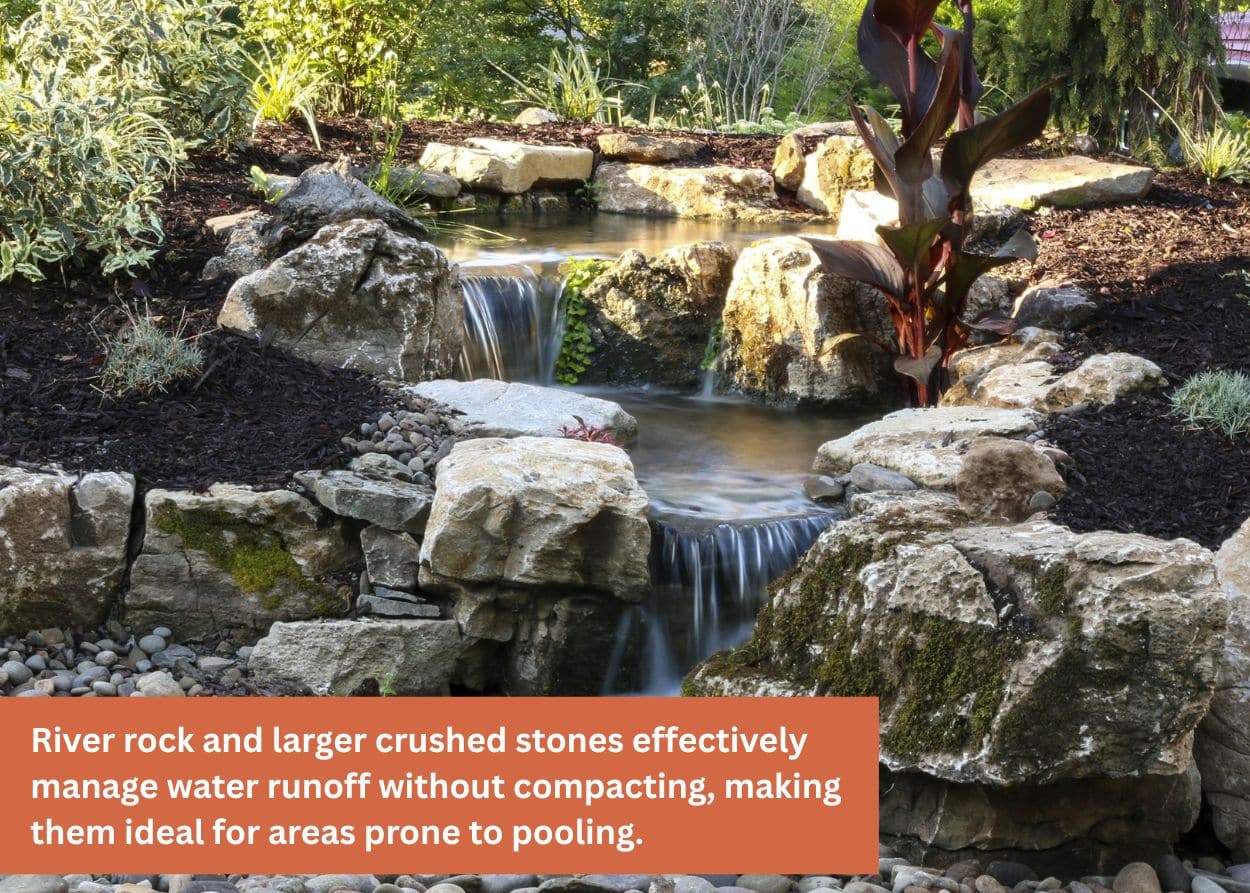
- Decorative Landscaping: River rock, 3/4-inch decorative stone, and colored pea gravel accentuate gardens, flower beds, and water features, providing attractive focal points.
How to Select the Right Type of Gravel
Choosing gravel involves matching your specific project needs with the characteristics of the gravel you need. Think about these factors as you’re shopping:
- Traffic & Durability: High-traffic areas, such as driveways, require durable gravel, such as crushed stone or quarry process, for long-term stability. A QP base layer with a crushed stone top provides a durable driveway surface that won’t shift as you drive on it.
- Comfort and Safety: For playgrounds, patios, and walkways, opt for smooth, rounded gravel, such as pea gravel, to enhance safety and comfort. If your little one falls, smooth stones won’t cause skinned knees like sharp gravel will. Round gravel is also easier on the feet, making walks around the garden in flip-flops and sandals comfortable and pleasant. It’s even believed that walking barefoot on rounded gravel has health benefits.
- Drainage Needs: In areas where water management is crucial, choose larger gravel types, such as river rock or sizable crushed stone, to ensure proper drainage. Your foundation, soil, and landscaping will thank you.
Picking the Perfect Gravel Size
Resist the temptation to say “size matters not” in a gravelly Yoda voice while selecting gravel sizes at the landscape center, because size does matter when picking gravel. Choosing the appropriate gravel size can significantly impact the success of your project, as the size of the medium will affect both the practicality and aesthetics of your project. For gravel size, we recommend:
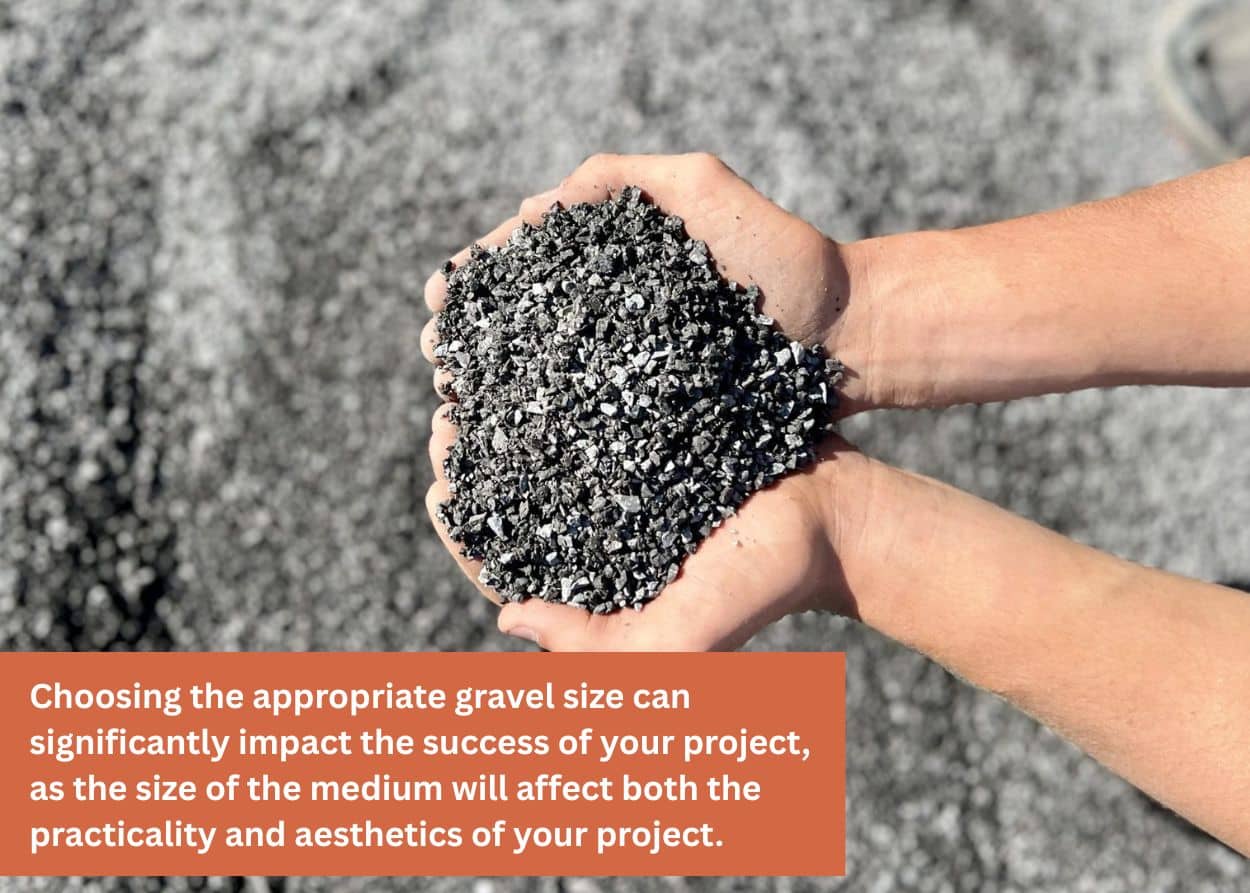
- Small (¼-inch to ½-inch): Ideal for decorative projects, comfortable walking paths, playground surfaces, and garden beds.
- Medium (¾-inch to 1-inch): A versatile choice suitable for general landscaping, driveway surfaces, and garden pathways.
- Large (1½-inch to 3-inches): Best for drainage solutions, large landscaping areas, edging garden beds, and reducing erosion.
Choosing the Right Gravel Color
Now that you’ve picked through your gravel by type, size, and function, it’s time to choose the color. If you’ve never considered how much work goes into landscaping with gravel before the stone is even purchased, don’t get discouraged. The end result is well worth it!
The color of your gravel can significantly enhance your landscaping design. Consider the aesthetics of your home and its surroundings, and select a gravel that suits your needs.
- Natural Earth Tones: Blend seamlessly with natural surroundings, complementing rustic or traditional landscapes.
- Bright Whites & Greys: Offer clean lines and modern aesthetics, ideal for contemporary gardens and pathways.
- Warm Reds & Browns: Ideal for creating inviting, cozy outdoor spaces that add warmth and depth to your landscaping.
For an extra level of complexity, you can use different colors for different areas to create depth and delineate them (e.g., separating pathways from flower beds). The landscape is your canvas, and the gravel is your paint!
Gravel Installation Tips and Tricks
Now that you’ve chosen the right gravel type, size, and color, you’re ready to rock! Ensure your gravel project succeeds with these essential installation tips:
- Preparation: Properly clear, level, and compact the base area, removing all vegetation and debris to establish a stable, durable foundation.
- Base Layer: Apply a solid base layer of quarry process or larger crushed stone for strength and long-lasting stability, particularly in high-traffic or driveway applications. To help keep your gravel in place, consider placing gravel stabilization grids before your final layer.
- Compaction: Use mechanical compactors or rollers to compact each gravel layer thoroughly, reducing settling and enhancing longevity.
- Drainage Consideration: Plan for proper drainage by creating a slight slope or installing drainage channels and French drains to prevent water pooling.
- Landscaping Fabric: Lay down landscaping fabric beneath gravel surfaces to inhibit weed growth and maintain a neat, tidy appearance. Landscaping fabric serves many purposes, two of which directly affect your gravel surfaces. The first is to create a separator layer between soil and gravel, so that the gravel won’t sink and mix into the soil over time. The second purpose is to prevent vegetation, such as weeds, from growing out of the soil and sticking out through the gravel.
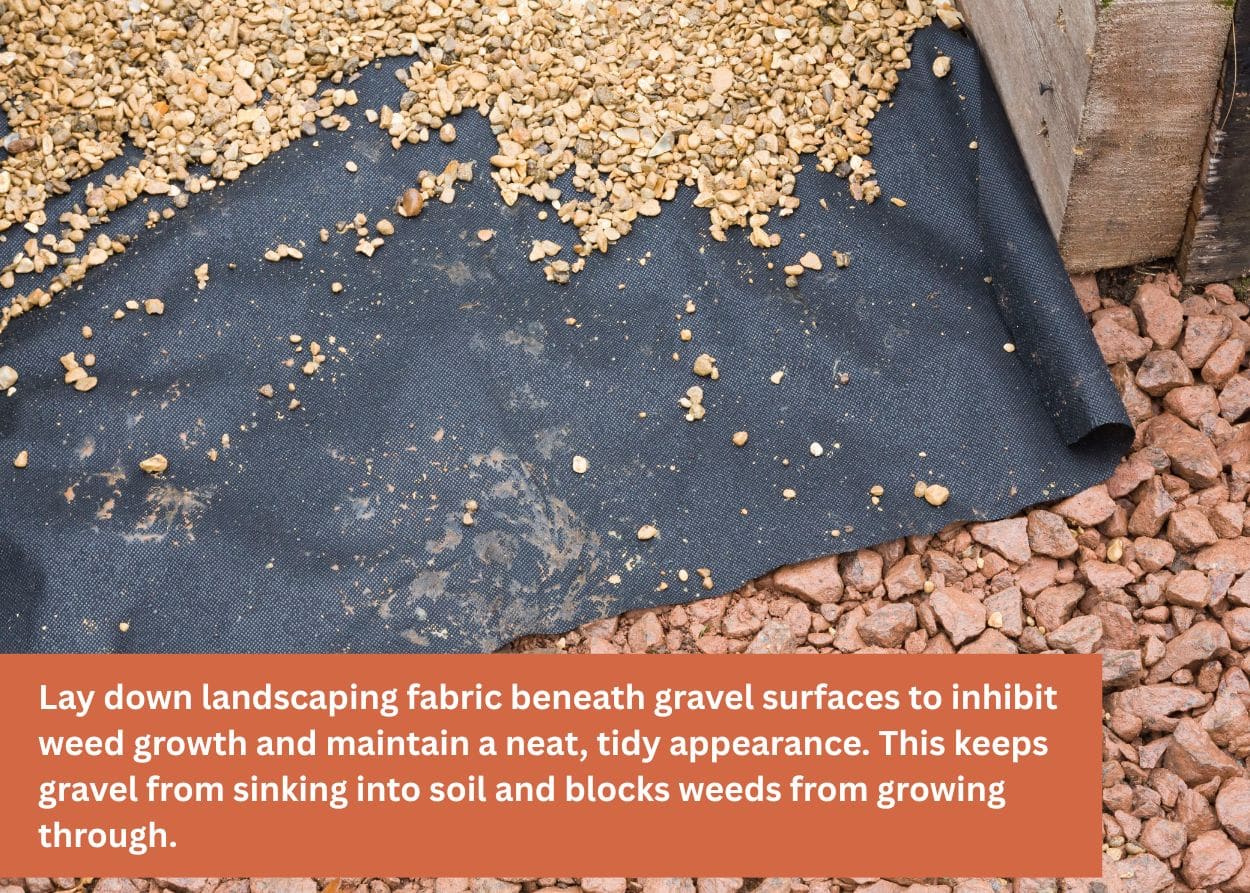
- Layer Thickness: Maintain an adequate gravel depth: typically 2-4 inches for decorative and low-traffic areas, and 6 inches or more for driveways and heavy-use paths.
- Edging: Install robust edging materials such as stone, metal, or plastic edging to contain gravel and maintain neat, defined borders.
Seasonal Gravel Maintenance Tips and Best Practices
You may ask, 'Why do I have to maintain my gravel?' Aren’t they just rocks that sit there?
The stone-cold truth is that gravel does move over time due to a combination of factors, including weather, vehicle and foot traffic, and gravity. The Death Valley Sailing Stones are a remarkable example of how nature can move rocks in unexpected ways.
So, to avoid having your gravel wander off, regular seasonal maintenance ensures your gravel surfaces remain functional and aesthetically pleasing year-round:
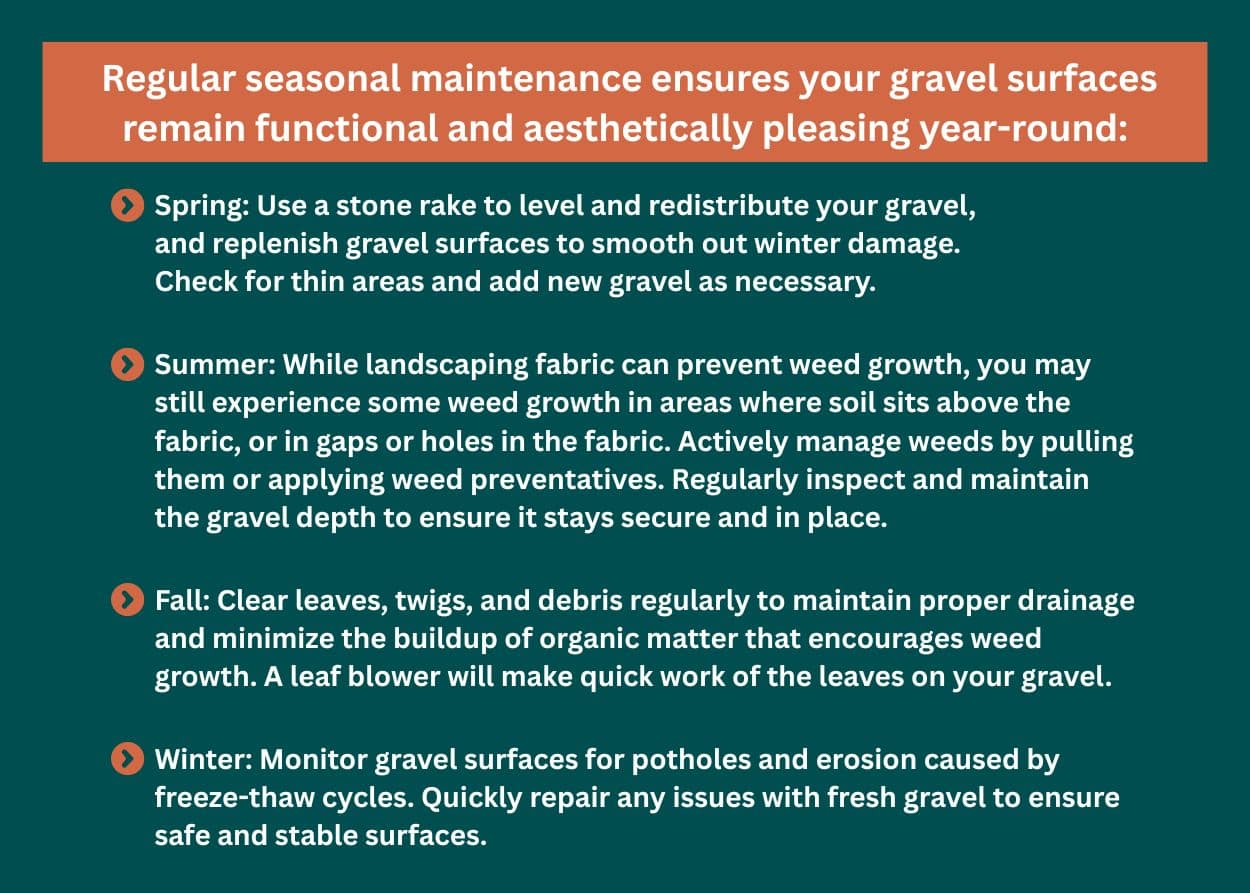
- Spring: Use a stone rake to level and redistribute your gravel, and replenish gravel surfaces to smooth out winter damage. Check for thin areas and add new gravel as necessary.
- Summer: While landscaping fabric can prevent weed growth, you may still experience some weed growth in areas where soil sits above the fabric, or in gaps or holes in the fabric. Actively manage weeds by pulling them or applying weed preventatives. Regularly inspect and maintain the gravel depth to ensure it stays secure and in place.
- Fall: Clear leaves, twigs, and debris regularly to maintain proper drainage and minimize the buildup of organic matter that encourages weed growth. A leaf blower will make quick work of the leaves on your gravel.
- Winter: Monitor gravel surfaces for potholes and erosion caused by freeze-thaw cycles. Quickly repair any issues with fresh gravel to ensure safe and stable surfaces.
Conclusion
It’s hard work, but gravel is hard stuff, so you’re in good company. However, by carefully considering your needs, preparation, and aesthetics, you can transform that hard work into a beautiful and functional landscape that’s both low-maintenance and high on joy.
At Terrascape Supply, we understand gravel. Our friendly, knowledgeable team in Hollidaysburg, PA, is always ready to help you choose the perfect gravel for your next project. Whether you're building a driveway, creating a garden pathway, or managing landscape drainage, we've got you covered. We also supply and deliver mulch, soil, fire pits and fireplaces, grills and ovens, outdoor furniture, and much more to meet all your outdoor living needs.
So contact us or stop by today to get started!
More Blogs
We’ve added more solid blogs you wouldn’t want to take for granite:
The Timeless Beauty and Efficiency of Natural Stone in Landscaping
From Patios to Pathways: Essential Hardscaping Materials Explained






